Current manager, Paulo Fonseca, has been in-charge at Serie A club Roma from start of the 2019-2020 season. A key character of his Roma side has been high press, fast pace, and young talent. Fonseca sets his team up to find spaces between the lines. In his own words – “I’m a believer in the interior game, capturing the space between the lines.” Playing attacking and overlapping fullbacks, with wider wingmen cutting inside, is a textbook characteristic of this Roma side. For tactical reasons or injury concerns, Fonseca has used six different players in that position this season. This data analysis aims to assess the six options he has at his disposal and attempts to zero-in on his best options given the roles in his setup scheme, purely based on data and statistics.
Pre-analysis
Fonseca sets this Roma team up in a seldom changed 4-2-3-1 tactics. They’ve played 81.3% of their games in a 4-2-3-1, switching sometimes to a 4-1-4-1 and a 4-4-2 on occasion.
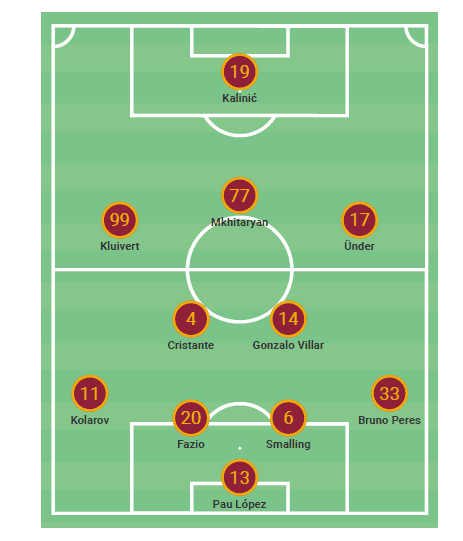
The six players that have played as wingmen for Roma this season are: Justin Kluivert, Nicolò Zaniolo, Cengiz Ünder, Henrikh Mkhitaryan, Carles Pérez and Diego Perotti. All of the mentioned players have played on either side of the pitch, and have also been played in varying pairs throughout the season. Since Pérez has played only 152 minutes for Roma this season, we haven’t included his statistics in the analysis. The analysis adds a 6th player to the list who although not used as much, has shown potential – Mirko Antonucci. Since he has not played much this season and is out on loan, the analysis considers his data for Pescara from the Serie B 2018/19 season.
Before we get into the data analysis, there are a few points to be made note of. First, given the formation and tactics favoured by Fonseca, Roma usually line-up with their wide-men in either of two roles – an inside forward or traditional winger. Depending upon the game it is either two wingers, two inside forwards, or one of each. Therefore, this data analysis primarily looks at these two roles and the players who best suit the roles by statistics. Second, all the data and statistics are from Wyscout, and of season 2019/20 (except for Mirko Antonucci: data from season 2018/19).
The common metrics
We’ve seen Roma play a 4-2-3-1 for 81% of their minutes on the field. This formation puts nearly as much attacking onus on the wingers as on the striker. Since both roles share a common position on the line-up, we first look at some metrics and traits which are common to both the roles. The below analysis makes use of the following metrics: xGC (goal contributions) per 90, Key passes per 90, and dribbles per 90 & accuracy.
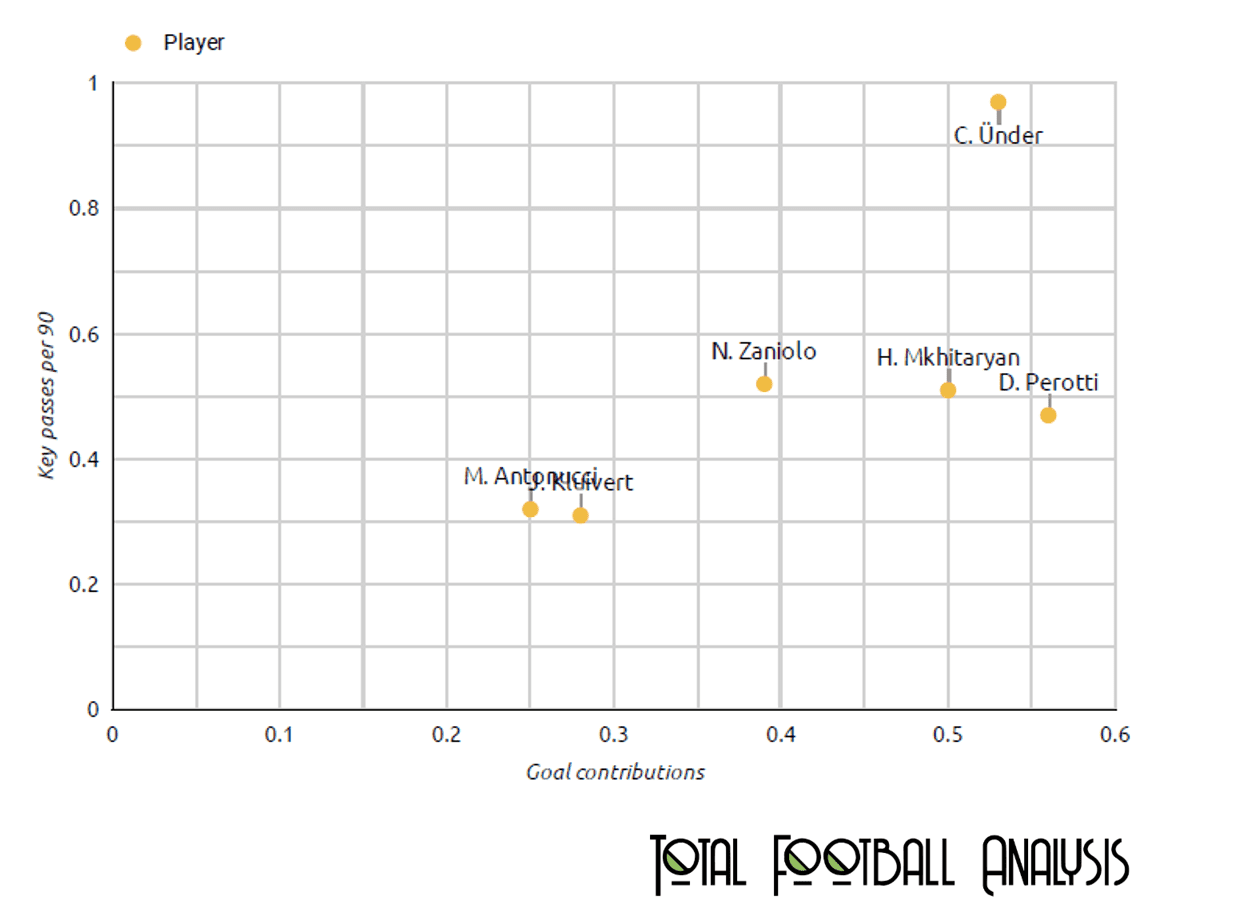
A key pass by definition is a pass that creates a clear goal-scoring opportunity. Expected Goal contribution (xGC), is the sum of xG/90 and xA/90 for the player. Ünder, has better statistics to show than everybody on the list, in terms of key passes made per 90. He’s created more number of clear cut goal scoring opportunities per 90 (0.97) than all of the players on the list. Even in terms of xGC (xG + xA), Ünder is only behind Perotti. He has a combined xGC of 0.53 (0.24 G + 0.29 A) per 90, as opposed to Perotti’s 0.56 (0.34 G + 0.22 A). Below is a chart that shows the xGC of all the players in the analysis.
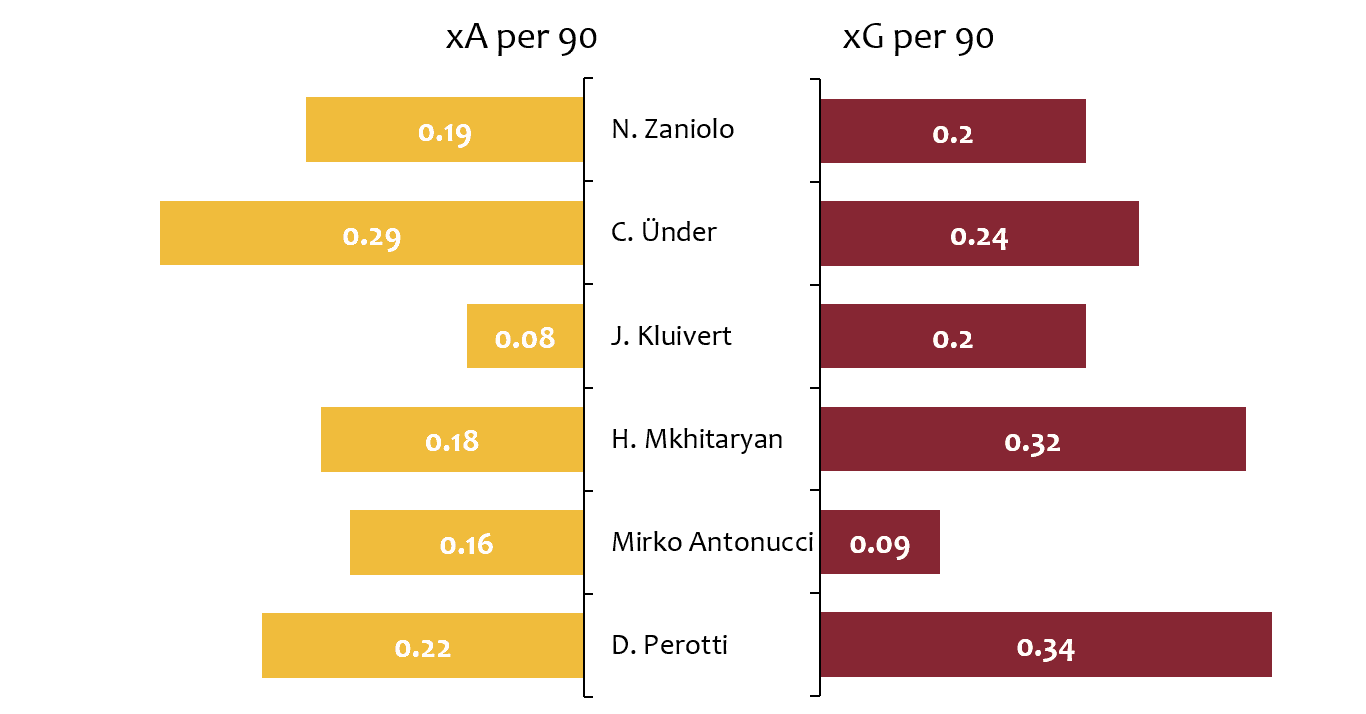
Another important ability that’s common between the two roles is the ability to dribble the ball. For this analysis, we look at the data for dribbles made per 90 and dribbles success rate.
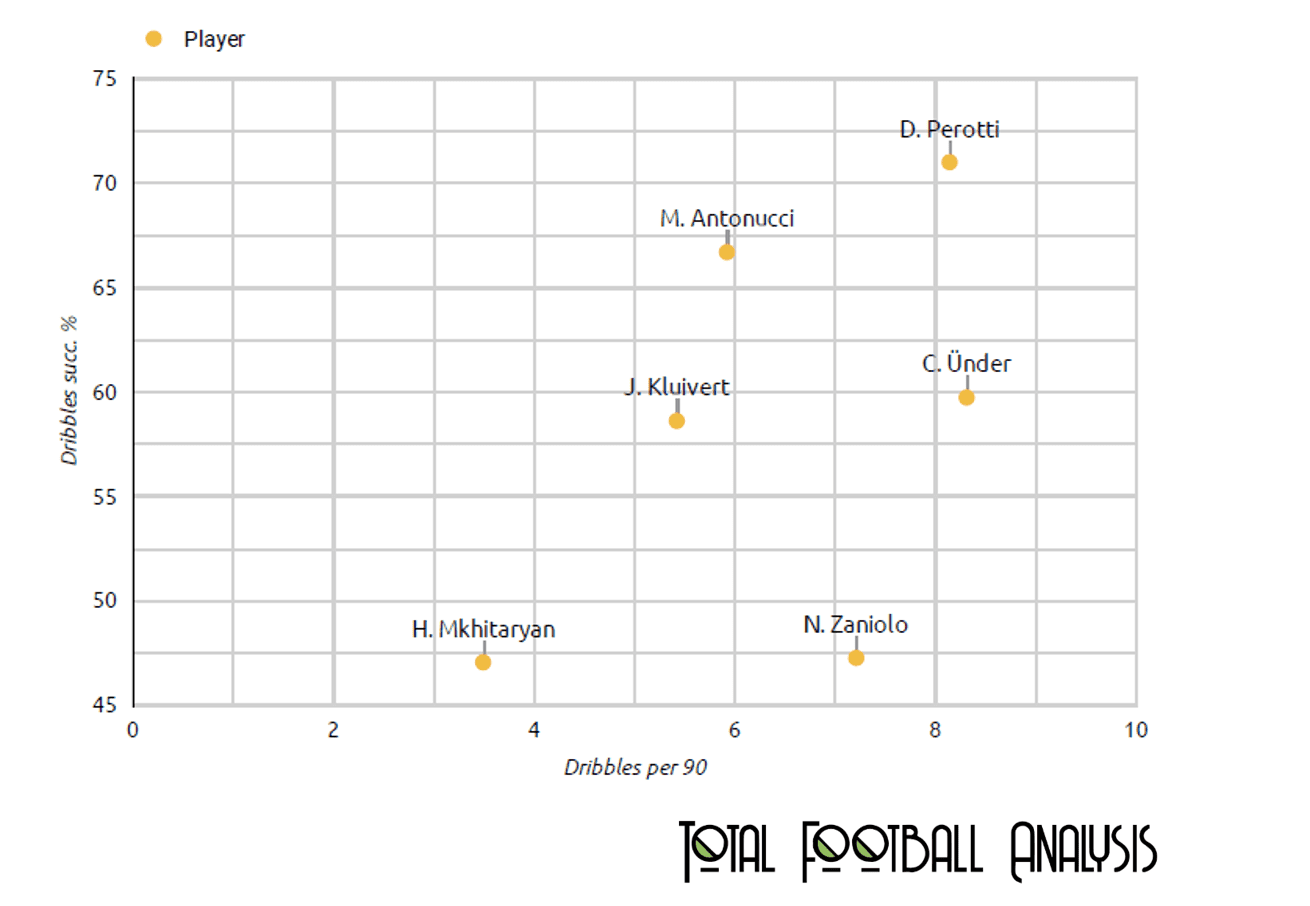
Ünder and Perotti both lead the way with 8.31 and 8.14 dribbles per 90, but Perotti has a far better success rate with 71.01% as opposed to Ünder’s 59.74%. Thus far, Ünder and Perotti lead the way in creativity (key passes), xGC, and dribbling abilities. However, does this mean they’re playing in the right positions? What about Kluivert, Zaniolo, Mkhitaryan and the challenger Antonucci? How do all of them fit into the two roles?
Inside forward
Fonseca has on numerous occasions stated his preference of fielding players who can cut-in between the lines and make space. By nature, an inside forward starts in the left or right-wing position and drifts inside the opposing full-back to find space between the lines. This not only helps create space in the final third but also allows the attacking team an extra man in the form of an overlapping wing-back/full-back. The attributes that the analysis considers while evaluating for an inside forward role are Goal contributions per 90, Dribbles per 90 & success rate of dribbles, shots per 90 & shots on target percentage, and the number of touches taken by the player in the box. The first two are common metrics across both roles which we have analysed previously; shots per 90 and shots on target percentage indicate shooting ability of the player and number of touches in the box indicates the frequency of the player to get into the box. The inside forward shoulders the goal-scoring responsibility along with the striker, and it is therefore important to look at not just the dribbling ability and goal contributions, but also the shooting ability. The below chart plots the shots per 90 and shots on target percentage.
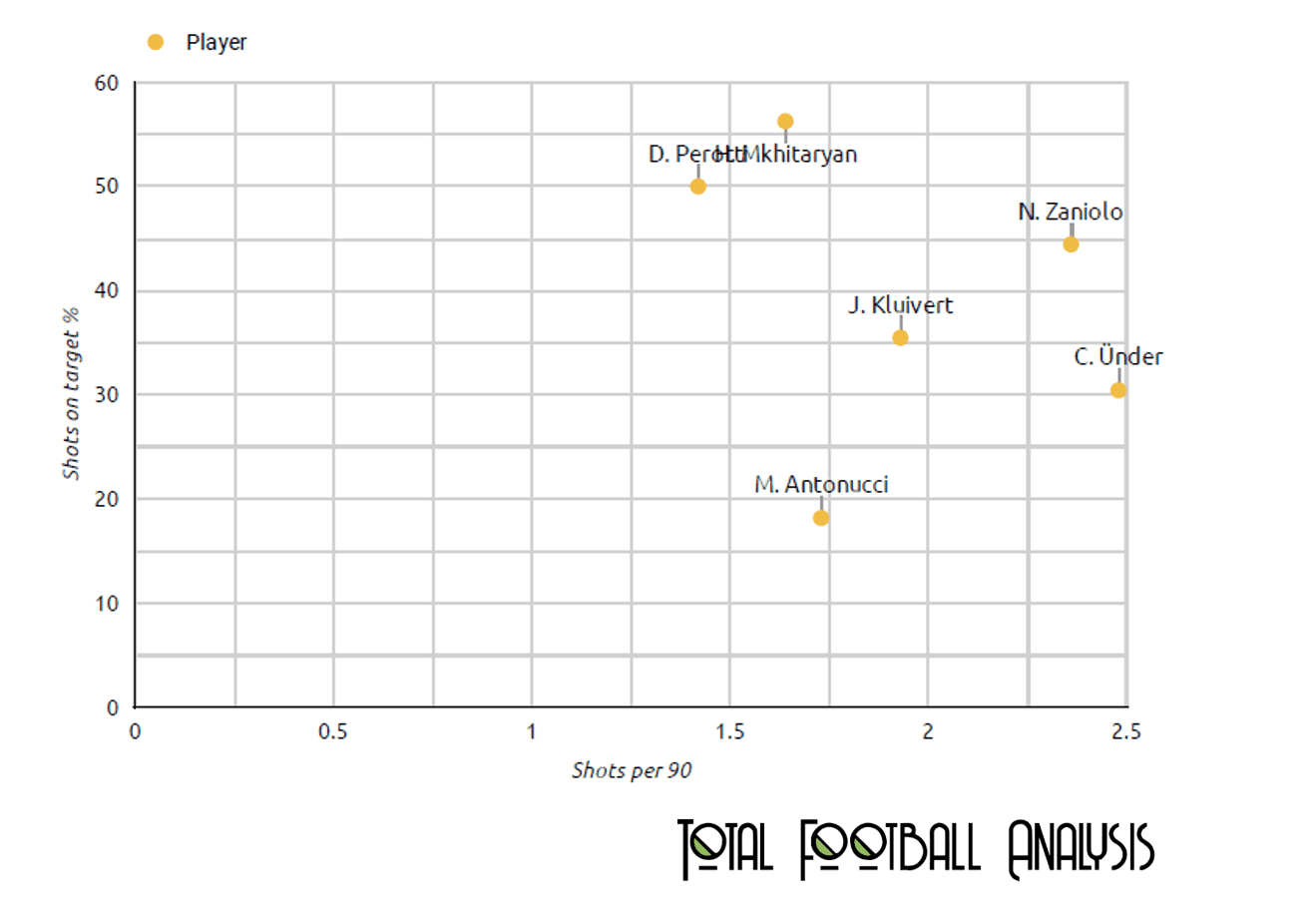
Ünder (2.48) and Zaniolo (2.36) take the most number of shots per 90. Ünder records a shot accuracy of 30.43%, lower than that of Zaniolo’s 44.44%. However, do these shots translate into goal contributions? While Ünder records a goal contribution of 0.53 from 2.48 shots per 90 at an accuracy of 30.43%, Zaniolo records 0.39 contributions from 2.36 shots per 90 at an accuracy of 44.44%. This indicates that in spite of having more shots and better accuracy, Zaniolo may possibly not be as lethal as Ünder in terms of finishing and placing the shots.
Also interesting to note is that despite taking the least number of shots per 90, Perotti (1.42) and Mkhitaryan (1.64) both fare better than Zaniolo (2.36) who has 0.39 goal contributions from 2.36 shots per 90. In comparison, Perotti has a goal contribution of 0.56 and Mkhitaryan of 0.50 per 90. This could be attributed to Zaniolo’s marginally poor shot accuracy of 44.44% as compared to Perotti’s 50% and Mkhitaryan’s 56.25%. We further layer this with a look at data on the number of touches a player has had inside the box per 90. This is an indicator of how well the player understands the game and how often is he inside the box to take the chances to score.
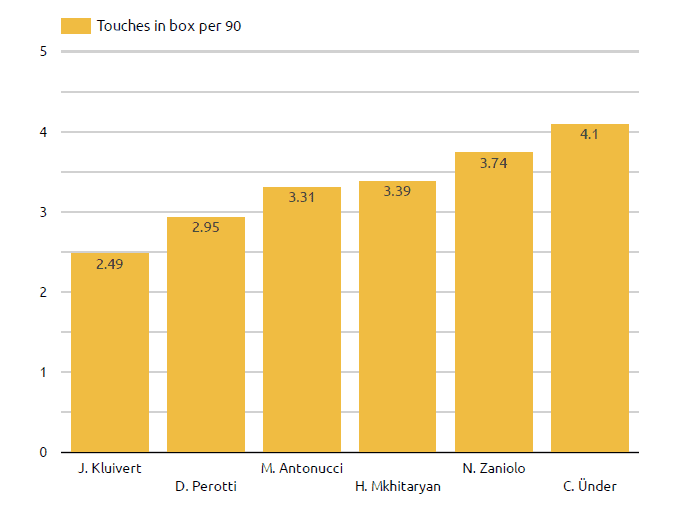
Ünder (4.1) and Zaniolo (3.74) make the most number of touches inside the box per 90, indicating their frequency to get closer to the goal. On the other end, Kluivert takes the least.
Through all of our analysis so far, we know that Ünder and Perotti lead the way in xGC, lead the way in dribbling ability and are more than efficient with shooting (Ünder takes more shots at lower accuracy, while Perotti takes fewer shots with greater accuracy). It also indicates that while Zaniolo may not lack the intent score goals (second-most shots & third best accuracy), but he does lack in movement (poor dribbles & accuracy) and maybe even the final finish (second-most shots, but low xGoal contributions). Perotti and Ünder on the other hand, are more lethal as finishers as compared to Zaniolo. The analysis also indicates that what Mkhitaryan lacks in movement (lowest dribbles & accuracy), he makes up with his positioning (touches inside the box) and finishing ability (lowest shots, but best accuracy). As an inside forward, Ünder and Perotti seem like the best starting choice along with Mkhitaryan & Zaniolo as back-up. Zaniolo represents an interesting future option if Mkhitaryan is not brought in permanently. Kluivert & Antonucci don’t suit the role.
Winger
The job description of an old-school winger involves hugging the side-lines and making runs to support the attack and defence. While moving forward the winger jinxes past his marker, beats them for pace and trickery, and puts in the perfect cross for the forward to score. The role of a winger is viewed more as a creator, who if can also score would be a big plus. For this analysis, the metrics considered are key passes per 90, dribbles per 90 & success rate of dribbles, crosses per 90 & crosses accuracy, and passes to penalty area per 90. We have previously analysed the first two metrics as they are common to both roles. Since the essence of a winger is to create chances for the forward, we first analyse the data to gauge crossing ability. The below chart plots crosses made per 90 and the accuracy of crosses made.

Ünder and Perotti show the best crossing ability per statistics, among all the players in this analysis. Ünder puts in 4.21 crosses per 90 at an accuracy of 30.77%, while Perotti puts in 3.66 crosses per 90 at an accuracy of 35.48%. Antonucci makes the third most crosses per 90 at 3.23 but his poor accuracy of 10% significantly lowers his impact. Zaniolo and Kluivert follow after Antonucci. Mkhitaryan displays the poorest crossing ability, with the fewest crosses per 90 and lowest accuracy. We further layer this data statistics on the number of passes a player has made to the penalty area per 90. This is a good indicator of the number of times the player had intended to create a chance for the forward, which is in-line with a winger’s role. The below chart shows the data for the same.
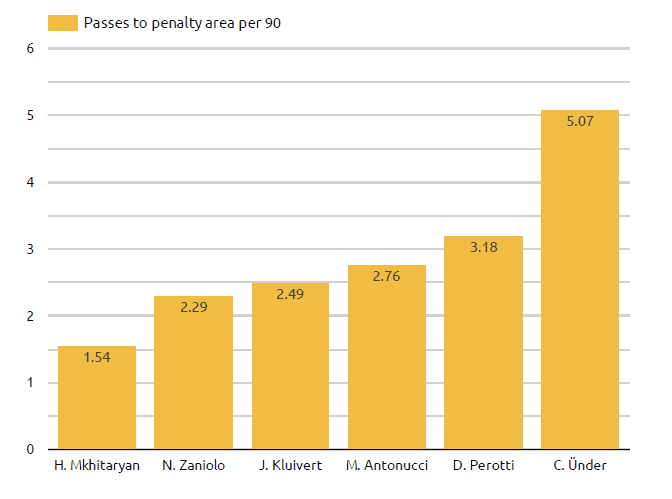
Here too, we see Ünder and Perotti making the most attempts at putting the ball into the penalty area. Ünder puts in 5.07 passes into penalty area per 90, while Perotti puts in 3.18 per 90. Antonucci follows them with 2.76 passes into penalty box per 90, followed by Kluivert & Zaniolo. Mkhitaryan at the other end again, making the least number of passes to penalty box.
We already know that Ünder and Perotti have a greater xGC and better dribbling ability among the players, from our analysis of common metrics. Add to that the winger analysis, and it shows that Ünder and Perotti display the best crossing ability as well. In addition to that, among the players in the analysis, Ünder and Perotti also make the most number of passes into the penalty area per 90. All of this tells us that Ünder and Perotti are the preferred choices of starting games, over the rest. Antonucci could be a possible backup if he can better his accuracy.
What does this mean for the players?
So, what does the data analysis of the six players tell us?
Cengiz Ünder
Paulo Fonseca’s wingman number 1. The 22-year-old records the best statistics for all the metrics in this analysis except for shots accuracy, which he makes up for with the sheer number of shots he takes per 90. His second-best xGC and best key passes per 90, more than efficient dribbling ability, and the number of touches in the box means that he definitely starts for Roma in the inside forward role. Ünder also records the best statistics for crossing ability and makes the most number of passes into the penalty area per 90. These stats indicate that he can most certainly also start for Roma in a winger’s role. Either way, a must start.
Diego Perotti
Paulo Fonseca’s wingman number 2. The 31-year-old records the highest xGC per 90. As a dribbler, Perotti has the second most dribbles per 90, and the best dribbling success rate. While he takes the second-fewest shots per 90, he records the second-best shot accuracy. He records the second-fewest touches in the opposition box. He could start for Fonseca in the role of an inside forward owing to his high xGC, and brilliant dribbling ability. What he lacks in shots attempted, and touches in the box, he makes up with his accuracy and clinical finishing. Perotti also records the second-highest crossing accuracy and second-most crosses per 90. He also makes the second most passes into the penalty area per 90. This means that he can also start as a winger for Fonseca.
Henrikh Mkhitaryan
He records the third most xGC and key passes per 90. However, his numbers for dribbling let him down. He attempts the least number of dribbles per 90, and has the lowest accuracy rate among all the players. Despite similar shooting abilities, Perotti takes preference over Mkhitaryan because of his much better dribbling ability. Therefore, Mkhitaryan can be an effective option in the squad in the role of an inside forward. Given his extremely poor dribbling ability, and compounded by his also equally poor crossing ability, Mkhitaryan cannot be an option as a winger at all.
Nicolò Zaniolo
This has been Zaniolo’s transition season from a midfield role to a wing role. Despite being new to the position, and the role, Zaniolo shows promise. While he does not have the most prolific stats for xGC (4th) or the best dribbling ability (third-most dribbles attempted but second lowest success rate), his shooting stats show he is keen to score goals. He also has the second-most touches inside the box, which means that he is constantly looking to get inside the box to score. He could, therefore, be a useful option as an inside forward. And if Mkhitaryan’s loan is not made permanent, Roma have a player who could become better if given more time (he’s all of 20!). While the shooting ability puts him in consideration for an insider forward role, the same cannot be said for the role of a winger. His poor dribbling stats, coupled with his weak crossing ability and low number of passes into the penalty area mean he wouldn’t be effective as a winger.
Justin Kluivert
This is a curious case. The ex-Ajax man Justin Kluivert became Roma’s youngest goalscorer in the Champions League in his first season. However, per statistics, his second season has been sub-par. His best statistic among all the metrics is that he has the third most shots attempted per 90, and third best crossing accuracy. By no means enough to even be considered a viable back-up option. Some re-thinking would do him good.
Mirko Antonucci
The 21-year-old Italian is an academy graduate of Roma. He is definitely not at a starter level for either of the roles, owing to poor xGC and key passes. He shows glimpses of decent dribbling with the fourth most attempted dribbles and the second-best dribbles success rate. However, his weak shooting puts him out of contention for an inside forward role. For the role of a winger, we already know he possesses decent dribbling ability. Add to that his third most attempted crosses and passes into the penalty box. This makes him a decent squad (read: cup competitions) option that can become better but only for the role of a winger.
Conclusion
Fonseca has all sorts of options for the two roles he favours. Some will give him pace, some movement, and some clinical finishing. Either way, he has his wingmen ready for the party.

Although some questions do lay in front of him – should Mkhitaryan be brought in permanently? Should Zaniolo be playing out wide? Can he get the best out of Kluivert? With the wealth of young talent available to Roma, it would be interesting to see how Fonseca can get the best out of them all.






Comments